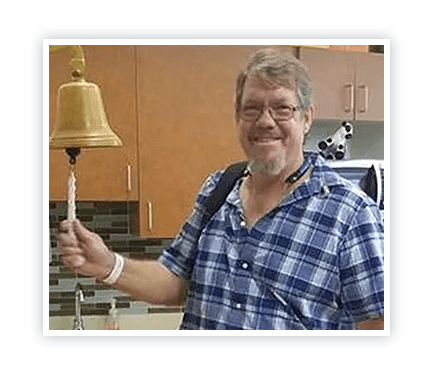01. Survivor Stories
Mesothelioma Survivor Stories
Mesothelioma survivor stories provide hope for patients recently diagnosed with mesothelioma. These stories can be inspirational for those undergoing treatment. They show long-term survival is possible with comprehensive mesothelioma treatments.
The mesothelioma community is small but supportive. Long-term mesothelioma survivors share their experiences and stories to inspire other patients. Mesothelioma survivors also often raise awareness about the dangers of asbestos fibers. They advocate for the mesothelioma community and people at risk of asbestos exposure.
Read about courageous mesothelioma survivors below.
Heather Von St. James: Pleural Mesothelioma Survivor
 Heather Von St. James was 36 years old when she was diagnosed with pleural mesothelioma. Her diagnosis came three months after giving birth to her first and only child in 2005.
Heather Von St. James was 36 years old when she was diagnosed with pleural mesothelioma. Her diagnosis came three months after giving birth to her first and only child in 2005.
Without treatment, Heather faced a prognosis of 15 months. She was not satisfied with this prognosis and decided to pursue an experimental, aggressive surgical procedure. The late Dr. David Sugarbaker pioneered the procedure at Brigham and Women’s Hospital. Heather and her husband, Cameron, felt the surgery would give her a chance at a long, cancer-free life.
Heather underwent an extrapleural pneumonectomy, which removed her cancerous lung and other impacted tissues. Her chest cavity was then bathed with a heated chemotherapy solution called HITHOC. After recovering from surgery, Heather underwent four chemotherapy sessions followed by 30 days of radiation therapy.
Heather’s surgery and following treatments were successful. She has been a pleural mesothelioma survivor for more than 18 years.
As a mesothelioma survivor, Heather has dedicated her life to raising awareness. Every year on the anniversary of her surgery, Heather and her loved ones celebrate Lung Leavin’ Day. The annual event celebrates survival and raises funds for mesothelioma research. Heather is a tireless advocate for mesothelioma patients. She continuously supports new cancer research and an asbestos ban.
Heather is also a contributor to Mesothelioma.com. She is happy to speak with patients and their loved ones about what to expect while fighting mesothelioma.
Paul Cowley: Pleural Mesothelioma Survivor
 Paul Cowley was diagnosed with malignant pleural mesothelioma in 2012 at age 34.
Paul Cowley was diagnosed with malignant pleural mesothelioma in 2012 at age 34.
Paul’s young age and good health allowed him to undergo an aggressive multimodal treatment plan.
The plan included two surgeries to remove tumors from his pleura and nearby tissues. Paul also underwent six rounds of chemotherapy.
Paul’s wife, Claire Cowley, said this period was “the hardest six months of his life.” However, perseverance made him stronger than ever. During this period, the couple also raised their young son, and Claire was Paul’s caregiver.
As a result of treatment, he has survived more than 10 years. Paul now spends time with his family he didn’t think he would have. He continues to raise awareness about the dangers of asbestos and mesothelioma.
Paul Kraus: Peritoneal Mesothelioma Survivor
 Paul Kraus was born into a Nazi camp in Austria. He later escaped with his family and moved to Australia. Because asbestos is abundant there, Australia has high rates of mesothelioma.
Paul Kraus was born into a Nazi camp in Austria. He later escaped with his family and moved to Australia. Because asbestos is abundant there, Australia has high rates of mesothelioma.
Paul was diagnosed with peritoneal mesothelioma in 1997. At diagnosis, Paul was given only months to live.
Paul turned to alternative treatments to halt the spread of his cancer. He keeps a strict diet, takes nutritional supplements and meditates.
Paul also regularly undergoes ozone therapy, which is considered a controversial treatment. Its effects on healthy cells, cancer cells and tumors remain unclear. Ozone therapy is not a recommended mesothelioma treatment. Paul also attributes his well-being to his positive outlook.
He is one of the longest-living mesothelioma survivors in the world and has written about his experiences.
Resources for Mesothelioma Patients
Jim Dykstra: Peritoneal Mesothelioma Survivor
 Jim Dykstra was diagnosed with peritoneal mesothelioma in 2013. Jim’s diagnosis of mesothelioma came after a testicular cancer diagnosis in 2011.
Jim Dykstra was diagnosed with peritoneal mesothelioma in 2013. Jim’s diagnosis of mesothelioma came after a testicular cancer diagnosis in 2011.
To treat his mesothelioma, Jim underwent cytoreductive surgery. His surgery was followed by hyperthermic intraperitoneal chemotherapy (HIPEC). Jim also underwent radiation and chemotherapy, and later immunotherapy.
When the cancer came back in 2020, Jim underwent another round of surgery and HIPEC. The recovery was tough and included fighting off a pancreatic infection. But Jim focused on positive ways to move forward.
Jim is still battling the disease today and is a 10-year mesothelioma survivor. Jim’s advice to other mesothelioma patients is to “be strong and remember you are not alone in this fight.”
02. Remembering Mesothelioma Survivors
In Remembrance of Late Mesothelioma Survivors
Although some mesothelioma survivors have passed away, many outlived their initial prognosis. Their stories still give hope to patients and highlight the importance of treatment advancements.
Learn about these cherished members of the mesothelioma community below.
Stephen Jay Gould: 20-Year Peritoneal Mesothelioma Survivor
 Stephen Jay Gould was a popular scientific author, paleontologist and evolutionary biologist. Gould authored more than 20 books and hundreds of essays published in Natural History magazine.
Stephen Jay Gould was a popular scientific author, paleontologist and evolutionary biologist. Gould authored more than 20 books and hundreds of essays published in Natural History magazine.
After Stephen’s diagnosis, he wrote “The Median Isn’t the Message.” It is an essay about his reaction to his diagnosis and poor prognosis. Stephen’s essay has been cited as a source of comfort and hope by many cancer victims.
He was diagnosed with peritoneal mesothelioma in 1982 and given a life expectancy of around eight months.
Stephen underwent multiple surgeries in combination with radiation and chemotherapy. After experiencing severe chemotherapy side effects, Stephen used medical marijuana. He credited the drug for its medicinal effects and for helping him stay positive throughout his treatment.
Despite his initial mesothelioma prognosis, Stephen lived 20 years after his diagnosis. He died in 2002 of lung cancer unrelated to mesothelioma.
Louise “Lou” Williams: 15-Year Peritoneal and Pleural Mesothelioma Survivor
 Louise “Lou” Williams was diagnosed with peritoneal mesothelioma in 2003. Lou’s diagnosis came after eight years of unexplained chronic fatigue and one year and a half of misdiagnoses. Her treatment consisted of surgical removal of the tumors and 18 sessions of chemotherapy.
Louise “Lou” Williams was diagnosed with peritoneal mesothelioma in 2003. Lou’s diagnosis came after eight years of unexplained chronic fatigue and one year and a half of misdiagnoses. Her treatment consisted of surgical removal of the tumors and 18 sessions of chemotherapy.
Lou initially overcame peritoneal mesothelioma but was diagnosed with pleural mesothelioma in 2009. Her pleural mesothelioma treatment involved three aggressive surgeries and chemotherapy.
Despite being told she had no more options in January of 2015, she insisted on continuing her fight.
She underwent a 14-day course of radiation followed by Keytruda. At the time, Keytruda was a new immunotherapy drug that had shown promise in clinical trials. Throughout her treatment, Lou advocated for the accessibility of new immunotherapy drugs and worked towards a global asbestos ban.
Lou sadly passed away on April 18, 2017, after surviving mesothelioma for nearly 15 years. Lou was a fierce advocate, educator and supporter of those affected by asbestos exposure and mesothelioma.
Mavis Nye: 14-Year Pleural Mesothelioma Survivor
 In June 2009, Mavis Nye was diagnosed with mesothelioma as a result of secondary asbestos exposure. She was given a prognosis of three months. Mavis underwent chemotherapy and then participated in several clinical trials to extend her life expectancy. After more than a year and several different drug combinations, the chemo stopped working.
In June 2009, Mavis Nye was diagnosed with mesothelioma as a result of secondary asbestos exposure. She was given a prognosis of three months. Mavis underwent chemotherapy and then participated in several clinical trials to extend her life expectancy. After more than a year and several different drug combinations, the chemo stopped working.
Mavis refused to give up and kept searching for another treatment option. She learned about an immunotherapy clinical trial testing Keytruda®️ (pembrolizumab). Her participation in the clinical trial allowed her to live years past her initial prognosis.
After more than 14 years of survivorship and significantly impacting the mesothelioma community, Mavis passed away on November 21, 2023. She was a dedicated mesothelioma and asbestos awareness advocate and the founder of the Mavis Nye Foundation, which helps support mesothelioma victims.
Emanuel Costa: 4.5-Year Peritoneal Mesothelioma Survivor

Emanuel Costa was diagnosed with peritoneal mesothelioma at age 35. Emanuel’s mesothelioma was treated with multiple rounds and types of chemotherapy, including Gemzar® (gemcitabine) and cisplatin.
After undergoing chemotherapy, Emanuel’s doctors recommended debulking surgery. Following a period of recovery, he again underwent chemotherapy, radiation and other treatments to stop the cancer’s spread.
Although his cancer continued to spread, Emanuel outlived his initial prognosis of six months. He survived four and a half years with the disease.
Emanuel is remembered by his wife, Gina Martucci, and their two children. Emmanuel’s daughter Sarah remembers his strength and perseverance during his cancer journey. The family continues to honor Emanuel’s memory by advocating for mesothelioma cancer research.
03. Improving Mesothelioma Survival
How Treatment Can Improve Mesothelioma Survival
Multimodal treatments and immunotherapy have had the biggest impacts on mesothelioma survival. Chemo can extend survival from 6 months (without treatment) to about 1.5 years. Immunotherapy may boost life expectancy to 1.5 – 2 years. Surgery-based treatments have helped patients live 3 years or more.
Among known long-term survivors, surgery-based treatments are the most common.
Some experimental treatments have also shown promise in clinical trials. Tumor Treating Fields, pressurized chemotherapy and other new treatments have extended survival for some patients.
Pursuing treatment generally gives mesothelioma patients a better chance of long-term survival. However, life expectancy can vary based on cancer type, stage and a patient’s health. Patients can discuss these factors with their doctors. Mesothelioma experts can explain how each factor may affect an individual patient.
“Survivorship is a test of resilience. I never understood when people told me that I was going to come out stronger, but now on the other side, I feel like I can do anything.”
Heather Von St. James
There is no cure for mesothelioma cancer, but there are factors that impact life expectancy. Many factors are out of a patient’s control, but some of the most important are not. For example, pursuing treatment from a mesothelioma doctor can improve prognosis.
Factors that impact long-term survival are:
- Age
- Early or late diagnosis
- A patient’s unique health factors
- Seeking treatment from a mesothelioma doctor
- Seeking treatment from a specialty cancer center
- Treatment approach
Patients can speak with their oncologists about these factors. A doctor can explain how each of them may affect an individual patient’s prognosis.
Can Mesothelioma Patients Achieve Remission?
Few mesothelioma patients go into remission, but it does happen. In medical literature, peritoneal mesothelioma patients appear more likely to experience remission. But a handful of pleural patients have also gone into remission.
Remission may give patients a sense of respite, but they still need to watch for recurrence. Patients should maintain long-term follow-ups and monitoring with their mesothelioma care team.
Patients and loved ones can find support for this journey in the mesothelioma community.
04. Support for Mesothelioma Survivors
What Support Is Available for Mesothelioma Survivors and Caregivers?
Navigating a mesothelioma diagnosis can be complex and overwhelming for many reasons. For instance, patients and caregivers often have to arrange travel for specialty care. This may require long-term housing, which can be costly. Patients also have to deal with health insurance claims and out-of-pocket costs.
The good news is patients and loved ones have several resources to help them through this time. They can work with mesothelioma attorneys to file a lawsuit against companies responsible for asbestos exposure. This can help cover the costs of treatment.
People affected by mesothelioma can also educate themselves on the lifestyle changes associated with cancer. This may include:
- Benefitting from support animals
- Celebrating life, hope and bravery in the face of cancer
- Handling the stress of check-up scans
- Practicing self-care as a cancer patient or survivor
- Prepping for a natural disaster as a cancer patient
Patients and loved ones should also consider joining a mesothelioma support group. These groups help people connect with the larger mesothelioma community. They can also provide a sense of understanding that is difficult to find elsewhere.
05. Common Questions
Common Questions About Mesothelioma Survivors
-
Has anyone survived mesothelioma?
- Yes, some patients have survived malignant mesothelioma. Patients generally live 18 – 31 months, with treatment. But survivors like Heather Von St. James and Paul Kraus have outlived their original prognoses by decades. Long-term survivors commonly undergo surgery-based combination treatments.
-
Who is the longest living person with mesothelioma?
- Paul Kraus is the longest living person with mesothelioma by nearly a decade. He was diagnosed with peritoneal mesothelioma in 1997. Kraus has taken an unusual approach to his treatment, but he has been a survivor for more than 25 years.









